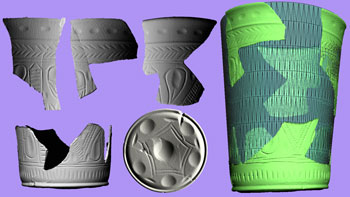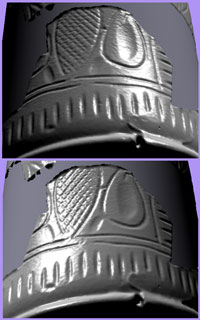Virtual Reconstruction of an Egyptian Beaker
by Marco Callieri and Flora Silvano
The Visual Computing Laboratory of ISTI-CNR, Pisa, frequently collaborates with museums and conservators-restorers in the development of new instruments that can be used in cultural heritage preservation, restoration and display. We present a small but interesting case study in which a broken artifact is virtually reconstructed and can be displayed with a user-friendly visualization tool.
The most immediate use for 3D models generated by scanning real objects is the preservation of their form for measuring purposes and documentation. But what can be done if the object is fragmented or incomplete? Thanks to the Department of Ancient World of the University of Pisa, we had the chance to work on an Egyptian artifact with such characteristics. Working with the digital model of the fragments, we were able to reconstruct the entire form of the object and enable users to interact with it via an ad-hoc display procedure. This kind of reconstruction can be obtained without altering the actual state of the artifact, unlike hands-on interventions using resins or other filling materials, and can be used to experiment and evaluate different alternatives.
The most complete piece of engraved glass found in the excavations at the site of Medinet Madi (Egypt) is a beaker of colorless glass (H. 15 cm.; D. rim 13.1), dated 2nd or 3rd century AD. The beaker has a rounded rim, straight sides and on the exterior presents a wheel-cut decoration. On the concave base there is a star-like motif consisting of a twice-outlined pentagon with slightly curved sides. There are five circular depressions in each semicircular space between the points and a single larger one inside the star. On the exterior surface there is a row of narrow oval facets running horizontally just below the rim, and below these a herring-bone pattern. The main register, with two horizontal grooves above and below, is composed of four panels divided by four vertical pillars of rice-shaped facets. Two of the panels show a diamond pattern with a floral design inside. The edge of the lozenge consists of a double row of slit-like facets, and four curving stalks with four rice-shaped facets. The other two panels are very fragmented and are characterized by a cross-hatched pattern with a double incised border. Unfortunately, no fragment of the upper part of the panel has been found and no similar pattern has been seen on related objects, so it is not possible to completely reconstruct the decoration.
|
The 3D scanning of a glass object is not an easy task as the laser light of the scanner passes through the transparent surface of the object. For this reason, the object was first coated with a white dulling powder and then acquired using a Minolta Vivid 900 3D scanner. The powder was then removed without any harm to the artifact. Different shots were taken of each fragment to ensure a complete (and precise) coverage of the surface. The shots were then aligned carefully using our software and merged. The result was four high-resolution 3D models describing the geometry of the single fragments. The figures show how the fine details of the artifact have been preserved in the 3D model; the engravings are mainly1.5mm wide and 0.4 mm deep.
Since most of the object is missing, it is not possible to reconstruct the beaker entirely without introducing artificial data. For this reason, we decided to use a 'real world' museum technique. A geometric template representing the beaker's external surface was built in order to position the fragments correctly. The program combined data extracted from the 3D model and sketches produced by museum restorers.
The fragments were aligned on the template with the help of our aligner tool. They were first positioned manually using the sketches as a guide; an automatic refinement process then aligned them precisely on the template.
Our visualization tool is a simple application, based on the OpenGL graphics library. For the purposes of this particular artifact, it has been implemented with a user-friendly interface: the object can be rotated and particular areas zoomed with simple movements of the mouse. The user can change the direction of the light to have a 'glazing light' visualization if he/she wants to enhance the geometric 'readability' of the object. It is possible to view just the original fragments or both the original parts and the whole beaker template. To guarantee that the tool can operate on older (less powerful) systems, different levels of geometric detail has been generated; the user can choose the level of complexity that best fits his/her requirements (fast object browsing or slow close-up examination).
Although not particularly innovative, we believe that this is a good example of a small, easy-to-use application targeted to the specific needs of inexperienced users, and implemented with state-of-the-art technology. It also represents a further step towards closer collaborations between the research community and the world of cultural heritage restoration.
Please contact:
Marco Callieri, ISTI-CNR, Italy
E-mail: marco.callieri![]() isti.cnr.it
isti.cnr.it
or Flora Silvano, Pisa University, Italy
E-mail: silvano![]() sta.unipi.it
sta.unipi.it

 This issue in
This issue in 

